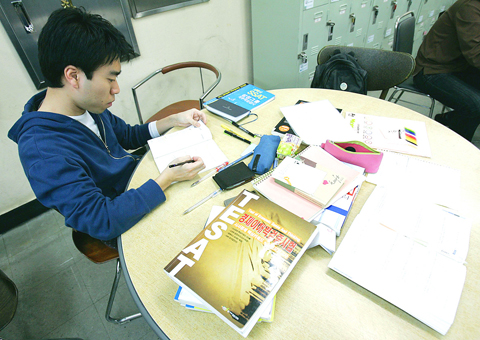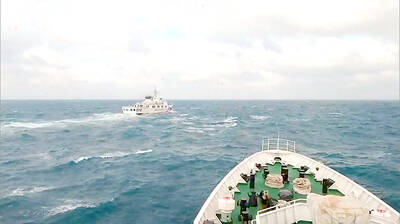South Korea’s newest batch of university graduates lives in fear of being trapped at the bottom of the pay scale in a group of workers dubbed the “880,000 Won Generation.”
The figure, equal to about US$650, represents about what a temporary staff or contract worker makes a month in net pay and is also a sign of the crushed dreams of the country’s youth who bet an elite education would lead to a rewarding career.
The current global crisis may cause South Korea to create its first generation of chronically underemployed and unemployed among the highly educated since the country emerged as a global economic power over the past few decades, experts said.

PHOTO: REUTERS
“Years ago, a diploma from a good university was a blank check for career success in Korea, but now it’s merely a certificate of unemployment,” said Cho, a university senior who asked only to be identified by her family name.
There are few places in the world where youth invest as much time and parents spend as large of a percentage of their income on education as South Korea, where cram schools are required to shut down by midnight so that students can have some sleep after studying for between 12 and 14 hours a day.
The goal has been entry to an elite university, which usually means a high-paying job, being considered a more desirable candidate for marriage and a level of prestige in the highly competitive society.
For many like Cho, the answer to the tough job market is even more education but experts are wondering if the current job crunch may be more than temporary and could signal an unraveling of social structures.
“There is a low empowerment level among people in their 20s,” said Woo Suk-hoon, an economics professor who coined the term 800,000 Won Generation in a recent book. “There is a much weaker social safety net in South Korea compared to what is offered in many OECD countries. This makes it easier for the country to sacrifice younger South Koreans in the labor market.”
A growing number of the young South Koreans have only been able to find temporary work. They see these posts as quicksand because the longer they stay, the more difficult it becomes for them to escape to join the regimented work force of regular workers who traditionally stay with one company for life.
The situation will likely get worse as the government predicts about 200,000 jobs will disappear this year while many private-sector economists warn of as many as 500,000 job losses.
Above a third of a million South Koreans aged between 20 and 29 were jobless in February, bringing the unemployment rate for the age group to 8.5 percent, more than double the nationwide jobless rate, the National Statistical Office said.
The government is aiming to ease the employment pinch through job-sharing and internship programs but Chu Duk-han, an activist who runs an online community for job seekers, sees this as nothing but a stop-gap measure.
“There are so many hopeless people who cannot even get those irregular jobs. The unemployment rate of the highly educated young people doesn’t tell the whole story. High school graduates are totally being excluded and ignored,” Chu said.
Kang Myung-koo, a 31-year-old high school graduate, said that he has not even been able to find a part-time job since last June when he lost a post at an online shopping mall in shipping.
“I am competing with college students for simple jobs with no age limits or academic requirements. I have nowhere to go. It’s hopeless. My bank account has dried up and the unemployment insurance benefits will stop soon,” Kang said.
Major employers such as Korea National Oil Corp, Hyundai Motor and the National Pension Service have said they plan to cut the wages of new hires.
In addition, many have said they will hire fewer regular employees and more contractors through internship programs.
“More and more companies are closing their doors for new full-time workers and hiring cheap interns instead,” said Park Young-ryeol, a professor of business administration at Yonsei University.
“I’m afraid this type of hiring is turning into a common practice,” Park said.

The Ministry of Foreign Affairs (MOFA) yesterday said it is closely monitoring developments in Venezuela, and would continue to cooperate with democratic allies and work together for regional and global security, stability, and prosperity. The remarks came after the US on Saturday launched a series of airstrikes in Venezuela and kidnapped Venezuelan President Nicolas Maduro, who was later flown to New York along with his wife. The pair face US charges related to drug trafficking and alleged cooperation with gangs designated as terrorist organizations. Maduro has denied the allegations. The ministry said that it is closely monitoring the political and economic situation

UNRELENTING: China attempted cyberattacks on Taiwan’s critical infrastructure 2.63 million times per day last year, up from 1.23 million in 2023, the NSB said China’s cyberarmy has long engaged in cyberattacks against Taiwan’s critical infrastructure, employing diverse and evolving tactics, the National Security Bureau (NSB) said yesterday, adding that cyberattacks on critical energy infrastructure last year increased 10-fold compared with the previous year. The NSB yesterday released a report titled Analysis on China’s Cyber Threats to Taiwan’s Critical Infrastructure in 2025, outlining the number of cyberattacks, major tactics and hacker groups. Taiwan’s national intelligence community identified a large number of cybersecurity incidents last year, the bureau said in a statement. China’s cyberarmy last year launched an average of 2.63 million intrusion attempts per day targeting Taiwan’s critical

‘SLICING METHOD’: In the event of a blockade, the China Coast Guard would intercept Taiwanese ships while its navy would seek to deter foreign intervention China’s military drills around Taiwan this week signaled potential strategies to cut the nation off from energy supplies and foreign military assistance, a US think tank report said. The Chinese People’s Liberation Army (PLA) conducted what it called “Justice Mission 2025” exercises from Monday to Tuesday in five maritime zones and airspace around Taiwan, calling them a warning to “Taiwanese independence” forces. In a report released on Wednesday, the Institute for the Study of War said the exercises effectively simulated blocking shipping routes to major port cities, including Kaohsiung, Keelung and Hualien. Taiwan would be highly vulnerable under such a blockade, because it

UNDER WAY: The contract for advanced sensor systems would be fulfilled in Florida, and is expected to be completed by June 2031, the Pentagon said Lockheed Martin has been given a contract involving foreign military sales to Taiwan to meet what Washington calls “an urgent operational need” of Taiwan’s air force, the Pentagon said on Wednesday. The contract has a ceiling value of US$328.5 million, with US$157.3 million in foreign military sales funds obligated at the time of award, the Pentagon said in a statement. “This contract provides for the procurement and delivery of 55 Infrared Search and Track Legion Enhanced Sensor Pods, processors, pod containers and processor containers required to meet the urgent operational need of the Taiwan air force,” it said. The contract’s work would be